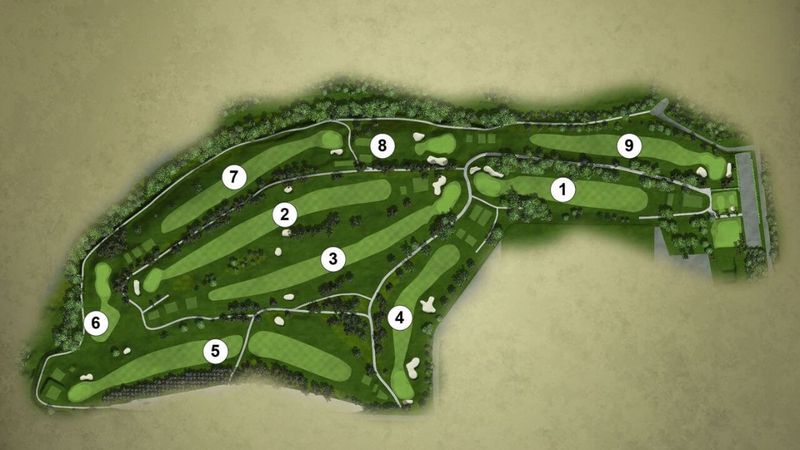Content Summary
When I first started playing golf I cut my teeth on our local 9 hole golf courses. The better players really didn't seem to want to waste their time with these smaller courses and it made for a less stressful experience than playing the full 18 holes with impatient experienced players waiting behind you.
Nine holes offer a condensed golf experience, perfect for those with limited time or seeking a less demanding game. For newer or less proficient players this is a unique opportunity to play a shorter, yet still satisfying, round of golf.
Many golf courses allow you to only play nine holes. Where I live they start a certain number of players on the back nine in the morning so the groups can be finished before the 18 hole groups comes through.
10 Key Factors Affecting How Long a Round of Golf Takes
- Player Proficiency: Golfers with a higher skill level tend to complete their rounds faster, thanks to their experience and familiarity with the game. Conversely, beginners and less experienced players may take longer to navigate the course and execute their shots.
- Course Complexity: The design, layout, and difficulty of a golf course can significantly impact the time it takes to play a round. Intricate courses with numerous hazards, tight fairways, and challenging greens require more time to maneuver, especially for less experienced players.
- Group Size: The number of players in a group can influence the pace of play. Larger groups generally take longer to complete a round, as more time is spent waiting for each player to take their shots.
- Pace of Play: Individual playing styles and preferences contribute to the overall speed of the game. Players who prefer a leisurely pace or require more time for strategizing will naturally take longer to complete a round, while faster players can speed up the game.
- Weather Conditions: Most golf courses get negatively affected by inclement weather, such as strong winds, rain, or extreme temperatures which can slow down play. Poor visibility, wet greens, or challenging wind conditions may require players to spend more time adjusting their strategies and executing their shots.
- Use of Golf Carts: Utilizing golf carts can speed up play by allowing players to travel between holes more quickly. However, players who prefer to walk the course will take longer to complete their round, depending on their walking speed and the course's terrain.
- Course Congestion: The overall busyness of the golf course can affect the time it takes to play a round. We all would love an empty golf course but if the course is crowded, players may experience delays as they wait for their turn to tee off or complete a hole.
- Golf Etiquette and Rules: Adherence to golf etiquette and rules can impact the pace of play. Players who follow proper etiquette, such as being ready to play when it's their turn and maintaining an appropriate distance from other groups, can help keep the game moving at a steady pace.
- Course Management and Strategy: Golfers who employ effective course management and strategic decision-making can save time during their round. Knowing when to take risks and when to play conservatively, as well as having a solid understanding of the course, can help maintain a steady pace.
- Warm-Up and Preparation: The time spent warming up and preparing for a round can indirectly affect the duration of the game. Golfers who invest time in practicing their swings and familiarizing themselves with the course layout beforehand may find themselves playing more efficiently, leading to a faster overall round.

How Long Does it Take to Play 9 Holes of Golf With 1 Player
The time it takes for a single golfer to play nine holes can vary based on factors such as skill level, course difficulty, and whether the player is walking or using a golf cart.
On average, a solo golfer can complete a nine-hole round in approximately 1 to 1.5 hours. This estimate assumes that the golfer maintains a reasonable pace of play and encounters no significant delays due to course congestion or other factors.
However, this is a general estimate, and the actual time can vary depending on the specific circumstances and the golfer's preferences.
How Long Does it Take to Play 9 Holes of Golf With 2 Players
The time it takes to play nine holes of golf with two players can vary depending on several factors, such as player skill level, course difficulty, and whether the players are walking or using a golf cart.
On average, a two-player round of nine holes typically takes around 1.5 to 2 hours to complete. This estimation assumes that both players maintain a reasonable pace of play and that there are no significant delays due to course congestion or other factors.
Keep in mind that this is a general estimate, and the actual time can vary depending on the specific circumstances of the game.
How About with 4 Players?
On average, a group of four golfers can expect to finish a nine-hole round in approximately 2 to 2.5 hours. This estimation assumes that all players maintain a reasonable pace and there are no significant delays due to course congestion or other factors.
The Final Tally: So, How Long Does It Take?
The time it takes to play nine holes varies significantly, with factors such as player skill, course complexity, number of players, course congestion and personal preferences.
Arriving early, having the right equipment, and familiarizing yourself with the course layout can help streamline the game. Proper preparation can save valuable time and enhance the overall golf experience.
Expect the time to be anywhere from 1-2.5 hours depending on the factors above.
A Little Deeper Look Into Playing 9 Holes
Walking or Riding
Walking or riding a golf cart can have a noticeable impact on the time it takes to play nine holes of golf. The choice between walking or riding will affect not only the individual golfer's pace but also the overall pace of play on the course.
Walking:
When walking, the time it takes to traverse the course is primarily determined by the golfer's walking speed and the course's terrain.
Generally, walking is slower than riding a cart, and this can increase the time it takes to complete nine holes. Using a push cart if you're walking minimizes fatigue.
However, walking may also allow for more time to think and strategize between shots, potentially leading to better decision-making that could offset the additional time spent walking.
Riding:
Using a golf cart can significantly reduce the time it takes to play nine holes. Golf carts enable players to move more quickly between shots and from one hole to another.
They are particularly useful on larger courses or those with challenging terrain that might be difficult to navigate on foot.
Moreover, golf carts can help golfers conserve energy, which might result in less fatigue and more consistent play throughout the round.

Course Difficulty
Course difficulty refers to the various challenges and complexities presented by a golf course, which can impact a golfer's performance and the time it takes to complete a round. Factors that contribute to course difficulty include:
Course Design and Layout:
The arrangement of holes, their length, and the overall course structure can significantly affect difficulty. A course with long holes, tight fairways, and a complex layout will generally be more challenging than one with shorter, more straightforward holes.
Hazards:
The presence and placement of hazards, such as water, bunkers, and out-of-bounds areas, can increase the course's difficulty. Golfers must navigate these obstacles strategically, which can require additional time and skill.
Greens:
The size, shape, undulation, and speed of the greens can contribute to course difficulty. Golfers need to read the greens accurately and adjust their putting technique accordingly.
Elevation Changes:
A course with significant elevation changes can be more challenging due to the need for precise club selection and adjustments to swing mechanics to accommodate uphill or downhill shots.
Rough and Fairway Conditions:
The thickness and length of the grass in the rough and fairway areas can influence difficulty. Dense rough and narrow fairways can make it harder for golfers to maintain control of their shots, leading to increased challenge and potentially longer playing times.
Weather Conditions:
Factors such as wind, rain, and temperature can affect course difficulty. Inclement weather can make the course more challenging by impacting ball flight, visibility, and the condition of the greens and fairways.
Course Maintenance:
The overall upkeep and maintenance of a course can impact its difficulty. Well-maintained courses with consistent greens and well-groomed fairways tend to be more predictable and easier to play than courses with inconsistent or poor maintenance.
Course Rating and Slope:
The course rating and slope provide an indication of the course's difficulty relative to other courses. The rating measures the difficulty for a scratch golfer (a golfer with a handicap of 0), while the slope measures the difficulty for a bogey golfer (a golfer with a handicap of around 18-20). Higher ratings and slopes indicate more challenging courses.
Play Ready Golf
Ready Golf is a popular concept that encourages golfers to play at a brisk pace to reduce the time spent on the course and improve overall pace of play. We save nearly half an hour when we incorporate ready golf into our games.
The primary focus of Ready Golf is to have players ready to play their shots when it is safe and appropriate to do so, instead of adhering strictly to the traditional order of play. Here are some key principles and tips to play Ready Golf:
- Be Prepared: Always be ready to play your shot when it's your turn, especially on a busy golf course. Have your club selection, yardage, and strategy in mind before reaching your ball.
- Continuous Putting: When on the green, putt continuously if it doesn't interfere with another player's line or distract them. Aim to finish out short putts without marking the ball, if possible.
- Tee Off When Ready: In the absence of any safety concerns or interference with other groups, players should feel free to tee off as soon as they are ready, even if they are not the farthest from the hole.
- Take Shorter Time for Pre-Shot Routine: Minimize the time spent on pre-shot routines, and avoid excessive practice swings.
- Plan Ahead: While waiting for your turn, study the course layout, check yardages, and plan your next shot.
- Lost Ball: If you believe your golf ball may be lost or out of bounds, play a provisional ball to save time searching for the original ball.
- Be Efficient on the Green: Mark and clean your ball, repair divots, and remove the flagstick promptly to speed up play on the green.
- Move Quickly Between Shots: Walk briskly between shots and maintain a good pace throughout the round.
- Share Responsibilities: When using a golf cart, share the responsibilities of driving and managing clubs to minimize slow play and save time.
- Communicate with Your Playing Partners: Inform your playing partners about your intentions and encourage them to play Ready Golf as well.

Balancing Speed and Enjoyment: Finding the Sweet Spot
While quickening the pace can save time, it's essential to strike a balance between efficiency and enjoyment. Remember to savor the nuances of the game and appreciate the camaraderie it fosters.
Embracing Golf's Evolution: Technological Advances
Technological innovations such as GPS devices, rangefinders, and swing analyzers can help the average golfer refine their skills and speed up the game. Embrace these advancements to enhance your golf experience and save time on the course.
Course Familiarity: Home Field Advantage
If you play golf on a familiar course you can shorten the time spent on the greens. Knowing the layout, hazards, and unique features of the course can enable golfers to make informed decisions and speed up their game.
The Importance of Recovery: Bouncing Back
Mistakes and setbacks are inevitable in golf. The ability to recover quickly from mishaps and maintain composure can prevent delays and keep the game moving forward.
Conclusion
While the time it takes to complete nine holes of golf can vary considerably, the game's multifaceted appeal transcends mere duration. The time spent playing golf offers valuable life lessons.
By embracing the numerous aspects of golf, from personal improvement and life lessons to social connections and time management skills, players can derive lasting value from each round – regardless of how long it takes.
By understanding the factors that influence golf's duration and being open to adapt, golfers can strike the perfect balance between efficiency and enjoyment, making the most of their time on the course.






